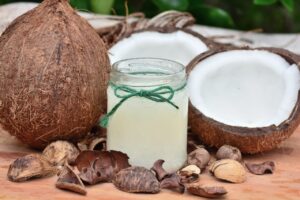
Let’s Explore Which Oil is Best for Oil Pulling?
Probably you noticed oil pulling before but did not try. It might be because you are unsure which oil is best for oil pulling? Here is a guide for you in order to understand the properties of oil preferred for oil pulling.
What is oil pulling?
Firstly, you need to understand what actually oil pulling is and what you can expect from it. Oil pulling is a medical approach in which you can use edible oil and swish it around your mouth for a particular time period and then spit it out, just like you do with a mouth wash. The experts believe that oil pulling is one of the best practices to improve oral and whole-body health (Tomar, et al, 2014). However, if you are confused about which one should be preferred for this practice, let’s get started.
Which oil is best for oil pulling?
Different oils contain certain properties, for instance
- Coconut oil

One of the most commonly used oils is coconut oil to perform oil pulling. You may usually use it in your food. However, it’s interesting to know that it has antibacterial properties that work to clear the bacteria from the mouth by diluting them during oil pulling activity. One can keep the bacteria away and clean your mouth efficiently with this process.
- Sesame oil

Sesame oil is the most recognized oil in Ayurveda world, which is also used in many medicines as it has antibacterial properties to control oral problems. If you ever undergo gingival plaque, this oil work amazingly for your oral health. The anti-oxidant and anti-inflammatory qualities assist in order to health bleeding gum problems and swelling. You may get multiple benefits by using sesame oil for oil pulling.
- Sunflower oil

If you are looking for something that helps in diluting tartar and thick plaque, bring sunflower oil for oil pulling. It removes all the plaque from the surface of your teeth.
- Olive oil

Another option that you can explore is olive oil for oil pulling activity. Its antibacterial properties prevent the development of organisms and remove existing bacteria efficiently.
You may feel confused still, as you don’t know which one among all the four is highly efficient and preferred. Here is the correct answer!
Coconut Oil 
A bacterium, Streptococcus mutans, plays a significant role in tooth decay and plaque buildup. Research shows that using coconut oil for a maximum of 20 minutes reduces the number of these bacteria in saliva in many adults. Basically, the fatty acid profile is favorable in coconut oil which contains a high amount of lauric acid and has antimicrobial properties. Coconut oil has an efficiency similar to chlorhexidine mouthwash for children in order to reduce S. mutans.
It has been researched that the inflammation of the gums causes gingivitis. It usually happens when the immune system begins to attack the bacteria in the plaque (Peedikayil, et al, 2014). Plaque-induced gingivitis can be treated with coconut oil as it has the tendency to reduce the markers of gingivitis significantly.
Reduce bad breath with coconut oil
Halitosis, also known as bad breath, is caused by the smell of chemicals and gases made in the mouth caused by the bacteria.
It has a strong association with gingivitis, infections, and poor oral hygiene. It is natural that taking care of oral hygiene and reducing the bacteria-causing smell can boost oral health.
In this regard, coconut oil plays a significant role by decreasing the markers of bad breath. It is as efficacious as chlorhexidine mouthwash. Therefore, you may use coconut oil in order to get rid of halitosis.
Alternate- Sesame Oil 
However, if you have no coconut oil in your home, you may do it with sesame oil as well. It has similar properties to coconut oil. In fact, some studies prove that sesame oil is even better than coconut oil for oil pulling.
Traditionally, sesame oil is one of the most preferred oils in order to practice oil pulling. It helps reduce plaque-induced gingivitis. It has been researched that the Root of Sesame (Sesamum indicum) possesses chlorosesamone. This chlorosesamone has an antifungal activity that essentially works best for oral health.
Additionally, research shows that sesame oil contains polyunsaturated fatty acids that ultimately help in reducing free radical injury surfacing in the oral cavity and improving overall oral health (Kaaliamoorthy, et al, 2018).
Oil pulling activity by using sesame oil removes all the toxins, parasites, and harmful bacteria from your mouth. Sesame oil, according to clinical trials, has shown efficient properties that reduce Streptococcus mutans and boost oral hygiene. Some studies analyze that sesame oil is even better than commercially available mouthwashes. You may feel an unpleasant aftertaste by using chlorhexidine. However, you may not experience an unpleasant taste after using sesame oil. It is quite a cheaper alternative.
Sesame oil may provide protection from the diseases of the gums, supports bone, and protects from tooth decay. Sesame oil ultimately strengthens gums, jaw, and teeth. Also, you may feel protection from dry mouth, dry lips, and throat.
Other Important Aspects
- Do you brush your teeth before or after oil pulling?

Before oil pulling, there is no need to brush your teeth. It’s because this practice will remove all the bacteria and food itself from your mouth. However, it is essential to ensure that all the toxins removed through oil pulling activity are drawn out of the mouth by brushing your teeth afterward.
- How often should I oil pull?
People who want to know how often they need to practice oil pulling are recommended to do it every day. However, those who do it once a week also experience all the benefits of oil pulling. What’s important is you should at least do it once a week and do it regularly for even better outcomes. Because it does not just improve your oral health but also stimulates digestion.
- Does oil pulling reduce belly fat?
Oil pulling has no recommended and confirmatory research on whether it helps reduce belly fat or promotes weight loss or not. However, it surely plays a significant role in liver cleansing.
- Do I rinse after oil pulling?
One tablespoon of coconut or sesame oil should be used for oil pulling, where you have to swish it for at least 10 to 15 minutes before spitting it out. Then you may rinse with plain tap water and brush your teeth afterward.
References
- Tomar, P., Hongal, S., Jain, M., Rana, K., & Saxena, V. (2014). Oil pulling and oral health: A review. IJSS Case Report & Reviews, 1(3), 33-37.
- Peedikayil, F. C., Prathima, S., & Arun, N. (2014). OIL PULLING THERAPY AND THE ROLE OF COCONUT OIL. E-Journal of Dentistry, 4(4).
- Kaliamoorthy, S., Pazhani, A., Nagarajan, M., Meyyappan, A., Rayar, S., & Mathivanan, S. (2018). Comparing the effect of coconut oil pulling practice with oil pulling using sesame oil in plaque-induced gingivitis: A prospective comparative interventional study. Journal of Natural Science, Biology and Medicine, 9(2).

Leave a Reply